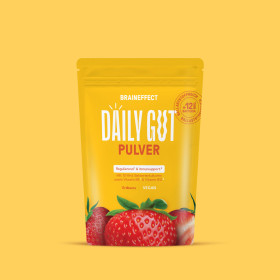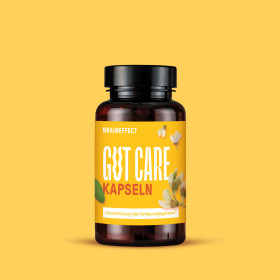
DHA and EPA: Why they are so important for your mental performance
Omega-3 fatty acids are the key to encouraging your brain to achieve top performance and optimise your mental performance. We will tell you exactly what it's all about and where to get valuable omega-3 fatty acids.

Omega-3 fatty acids are the key to spurring your brain to top performance and optimizing your mental performance. DHA and EPA can help you take your mental performance to a new level. We will tell you exactly what this is all about and where you can get the valuable omega-3 fatty acids.
Inhaltsverzeichnis
1. DHA and EPA for your mental power
Besides water, your brain consists mainly of fat. 30% of dry matter is DHA alone. This is why doctors and researchers agree: You should regularly consume the omega-3 fatty acid DHA for your mental performance.
Docosahexaenoic acid (DHA) and eicosapentaenoic acid (EPA) are two of the three omega-3 fatty acids. They belong to the polyunsaturated fatty acids. Because the essential fatty acids cannot be produced by the body itself, they must be taken in through food.
The valuable fatty acids are found in nuts or seeds, for example, but these vegetarian sources contain mainly the omega-3 fatty acid ALA (alpha-linolenic acid) and no DHA and EPA. ALA can be converted to DHA and EPA in our body, but only up to about 5%, which is often not enough to be healthy and efficient.
So what do we need DHA and EPA for anyway? DHA is especially important for your brain and concentration, while EPA is especially good for the heart. Here you can read more about the differences between DHA and EPA and find out which omega-3 fatty acids you need to get through the day with energy and concentration.
2. What is DHA?
Docosahexaenoic acid (DHA) is a polyunsaturated fatty acid. It is one of the omega-3 fatty acids and therefore perfectly suited to support your mental performance. DHA is found in certain seaweeds and tiny crustaceans, among other things, and is therefore found in all living creatures that feed on it.
Naturally, however, these algae and crabs are mainly on the diet of marine animals. In the highest concentration, DHA is found in fatty sea fish such as salmon. Studies are currently investigating the effect of DHA on your blood pressure and heart rate [1].
DHA is also particularly important for your brain. Up to 97 percent of the omega-3 fatty acids in your brain consist of DHA. This is why DHA is so important for your brain activity and thinking, your learning ability and reaction time, and many other neurological processes that affect your mental performance.
DHA and learning ability:
Without DHA no brain power, you need it for the normal and good activity of your brain. So if you need more power for the next exam or on the job, DHA is the right choice for you.
DHA and reaction time:
A daily supply of DHA can contribute to normal mental performance and thus also fast reaction time in terms of recalling memories.
Take-Home-Message #1: DHA is an omega-3 fatty acid that is found mainly in fatty sea fish and is particularly important for your brain. An optimal DHA supply can, therefore, support your thinking and learning ability.
3. What is EPA?
Eicosapentaenoic acid (EPA), like DHA, is one of the omega-3 fatty acids and is also derived from fatty sea fish. You have never heard of EPA? Many have! They know DHA, but they don't know that EPA is at least as important.
Recent scientific studies show that EPA is particularly important in promoting positive emotions [2]. EPA is also thought to have a positive effect on the heart, especially in times of stress. This is why not only the Cross-Fit World Federation recommends a daily intake of EPA, but also many sports doctors.
Take-Home-Message #2: EPA is also an Omega-3 fatty acid. In contrast to DHA, it helps your body during strenuous exercise and can have a positive effect on your mood.

4. EPA or DHA? That is the question here!
So what now? EPA or DHA? Both seem to bring some benefits to physical well-being. The answer sounds simple at first: Both fatty acids are mainly found together! However, you can pay attention to the different EPA and DHA foods or dietary supplements.
If you primarily want to support your concentration and mental performance, for example, to learn better or to be able to react faster at the next football match, then you should pay attention to a DHA-rich diet.
If your goal is to push yourself to your limits, an EPA-based diet is of greater benefit.
Studies show that EPA and DHA together can even boost your BDNF levels. A little digression: BDNF is responsible for the renewal of brain cells and thus for the development of our memory.
Where do you get DHA and EPA? DHA and EPA are found in high concentrations in tuna, sprat, salmon or herring, for example, but in algae. Therefore you should eat good and fatty fish 3 times a week.
Take-Home-Message #3: Depending on your requirements and needs, either DHA or EPA is better suited for you. If you want to learn more about "optimal nutrition for more power", sign up now for our Performance Newsletter. In the newsletter, you will be the first to be informed about discount campaigns and you will also receive new hacks for your optimal nutrition every week.
5. Vegan Omega 3 as DHA and EPA source
There are a number of vegan omega-3 sources. However, many of them are only rich in the omega-3 fatty acid ALA, only a small part of which can be converted to DHA and EPA. If you want to effectively supplement DHA and EPA with a vegetable omega-3 alternative, algae oil is the right source for you.
BRAINEFFECT HACK: Fish that are rich in the omega-3 fatty acids DHA and EPA get their high levels of these fatty acids from either krill or the algae themselves. The algae is therefore the natural source of DHA and EPA.
6. Krill oil - the DHA and EPA superhero
You don't have time to put fish on your menu three times a week? Or no good fish store near you? Then you can cover your weekly EPA & DHA needs alternatively with food supplements.
Many people consume cod liver oil, fish oil, and similarly unpleasant products on a daily basis to do something for their omega-3 balance. The far more efficient alternative for DHA and EPA is krill oil. What makes it so extraordinary?
It has all the advantages of conventional fish oil, but in addition, it has many other unique properties. For example, it can be better absorbed by the body and increases the omega-3 index in the blood for longer periods of time. Krill oil is obtained from krill crabs.
These are tiny organisms that live in the cold waters of Antarctica, far from industrial pollution. The combination of the animal's short life cycle, excellent environmental conditions, and sustainable fishing methods contribute to krill being one of the purest sources of DHA and EPA.
Why do many athletes and biohackers prefer krill oil over fish oil?
- Studies show the better bioavailability of krill oil because it is present in the natural omega-3 matrix of our cells. Therefore you only need about 1/4 of the normal fish oil.
- Take fewer Krill Oil capsules per day as compared to fish oil
- Reduced exposure to heavy metals
- No taste of fish
- High Omega-3 content and high EPA & DHA dose
Furthermore, krill oil has a high EPA and DHA value and is, therefore, one of the best sources for a good EPA & DHA supply. The best way to combine krill oil with more fish is to add it to your diet.
Take-Home-Message #4: High-quality krill oil can be obtained from the arctic krill crabs. Because they live far away from industrial pollution, they are the purest source of Omega-3 fatty acids with a high content of EPA & DHA. We recommend a dosage of approx. 250-260mg DHA & EPA per day.
7. Conclusion
EPA and DHA should be two of the most important companions on your way to the best version of you. These two essential fatty acids can only be taken in through food and are essential for your brain and heart. So eat fatty fish 3 times a week or use supplements with high-quality krill oil.
8. Sources
[1] Hypertension. 34(2), 1999, S. 253-260
[2] Lipids. 31, 1996, S. 157–161
[3] Journal of the American College of Nutrition. 28, 2009, S. 525–542
[4] Bunea R et al., Evaluation of the effects of Neptune Krill Oil on the clinical course of hyperlipidemia S. 40
[5] Sampalis F et al., "Effekte von Krillöl bei prämenstruellem Syndrom" Altern Med Rev. 2003 May; 8



